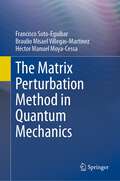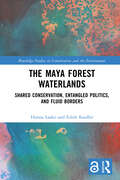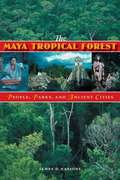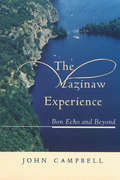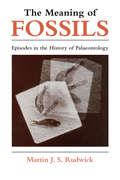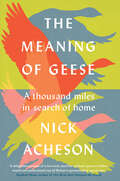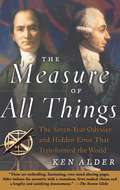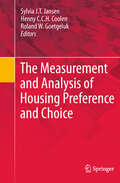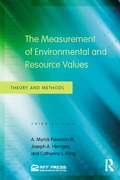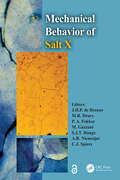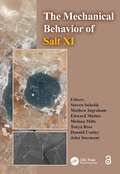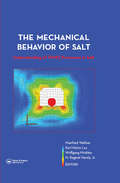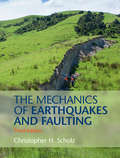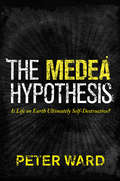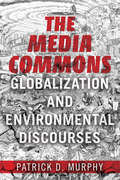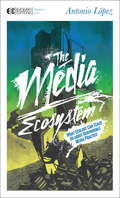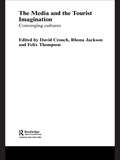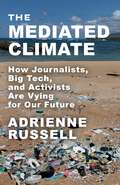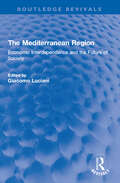- Table View
- List View
The Mathematics of the Universe
by Soledad Romero MariñoThe lyrical verses and captivating illustrations of this picture book explore how the concepts and patterns of mathematics shape the natural world. The universe seems in such disarray, but it follows an order, not one thing astray. So the planets and stars have been created, atoms brought together as if they were fated. Nature's secrets are brought to life through an innovative blend of science, poetry, and art, making complex math concepts accessible and engaging for children aged five to nine. Young readers will discover the hidden mathematical patterns in everyday phenomena, from honeycombs and butterflies to celestial bodies and intricate geometric shapes. • This charming STEM educational resource encourages students to see the world through a mathematical lens. • Spheres, hexagons, symmetry, fractals, and spirals are among the concepts explored. • Each mathematical concept is presented alongside an observation, linking math to the universe's natural rhythms. • Thought-provoking quotes from renowned figures such as Galileo, Marcel Proust, and Jules Verne add depth to the learning experience. • The book’s large size, die-cut cover, and gorgeous art make it ideal for gifting and displaying.
The Matrix Perturbation Method in Quantum Mechanics
by Francisco Soto-Eguibar Braulio Misael Villegas-Martínez Héctor Manuel Moya-CessaThis book provides an alternative approach to time-independent perturbation theory in non-relativistic quantum mechanics. It allows easy application to any initial condition because it is based on an approximation to the evolution operator and may also be used on unitary evolution operators for the unperturbed Hamiltonian in the case where the eigenvalues cannot be found. This flexibility sets it apart from conventional perturbation theory. The matrix perturbation method also gives new theoretical insights; for example, it provides corrections to the energy and wave function in one operation. Another notable highlight is the facility to readily derive a general expression for the normalization constant at m-th order, a significant difference between the approach within and those already in the literature. Another unique aspect of the matrix perturbation method is that it can be extended directly to the Lindblad master equation. The first and second-order corrections are obtained for this equation and the method is generalized for higher orders. An alternative form of the Dyson series, in matrix form instead of integral form, is also obtained. Throughout the book, several benchmark examples and practical applications underscore the potential, accuracy and good performance of this novel approach. Moreover, the method's applicability extends to some specific time-dependent Hamiltonians. This book represents a valuable addition to the literature on perturbation theory in quantum mechanics and is accessible to students and researchers alike.
The Maya Forest Waterlands: Shared Conservation, Entangled Politics, and Fluid Borders (Routledge Studies in Conservation and the Environment)
by Hanna Laako Edith KaufferThis book examines the entanglements and blurred edges of nature conservation and geopolitical relations in the borderlands of the trinational Maya Forest.Maya Forest is an umbrella term for transboundary conservation developed by scientists and conservationists in the 1990s to protect the threatened rainforest in the borderlands of Mexico, Belize, and Guatemala. Currently, the Maya Forest is a biodiversity hotspot composed of a network of protected areas and heritage sites. However, issues related to water, land, and forests have often been treated as separate political units, and not as part of the same history. Written by two authors with decades of hands-on experience in this region, this book sheds light on the complex dynamics by which conservation and natural resource management geopolitically shape borderlands such as the Maya Forest. The book introduces the novel concept of forest waterlands as borderlands and fluid edges, which are now subject to concern by conservationists. These are entangled spaces in which conservation, peoples, and politics interact, connect, and disconnect with the nexus of waters, forests, and lands. The book sheds light on the building and mapping of the Maya Forest ecoregion, with particular attention to water as an often neglected, but unifying element. It showcases how the Maya Forest is a distinct region characterized by transformations entangled with the Maya, trails of biological stations, the shared history of chicleros (chewing-gum hunters), fluid international rivers and transboundary basins, and various geopolitical discrepancies. It offers a contemporary glimpse into the Maya Forest’s intertwined bio- and geopolitics, which urge us to rethink borders and boundaries.This book will be of great interest to students and scholars of nature conservation, global environmental politics, geopolitics, borderlands, international relations, and natural resource management.
The Maya Tropical Forest: People, Parks, and Ancient Cities
by James D. NationsThe Maya Tropical Forest, which occupies the lowlands of southern Mexico, Guatemala, and Belize, is the closest rainforest to the United States and one of the most popular tourist destinations in the Western Hemisphere. It has been home to the Maya peoples for nearly four millennia, starting around 1800 BC. Ancient cities in the rainforest such as Palenque, Yaxchilan, Tikal, and Caracol draw thousands of tourists and scholars seeking to learn more about the prehistoric Maya. Their contemporary descendants, the modern Maya, utilize the forest's natural resources in village life and international trade, while striving to protect their homeland from deforestation and environmental degradation. Writing for both visitors and conservationists, James Nations tells the fascinating story of how ancient and modern Maya peoples have used and guarded the rich natural resources of the Maya Tropical Forest. He opens with a natural history that profiles the forest's significant animals and plants. Nations then describes the Maya peoples, biological preserves, and major archaeological sites in Mexico, Guatemala, and Belize. Drawing on more than twenty-five years of conservation work in the Maya Tropical Forest, Nations tells first-hand stories of the creation of national parks and other protected areas to safeguard the region's natural resources and archaeological heritage. He concludes with an expert assessment of the forest's future in which he calls for expanded archaeological tourism to create an ecologically sustainable economic base for the region.
The Mazinaw Experience: Bon Echo and Beyond
by John CampbellThe Mazinaw, a place of striking natural beauty, is famous for Bon Echo Rock, a massive sheer cliff, dropping into one of Ontario’s deepest lakes. The Mazinaw Experience traces the presence of human habitation on the shores of the Mazinaw from its earliest beginnings to the present, from the nomadic Aboriginal people who believed the cliff top to be a sacred place and the rugged lumbermen whose entrepreneurial zeal cleared out the mighty pine, to the settlers who struggled to create new lives for their families. Mini-profiles of personalities such as Johnny Bey and Billa Flint, along with stories involving colonization roads, the settlement towns, the mining and the coming of the railway, provide insights into the Mazinaw area of today. The memory of Bon Echo Inn lives on in Bon Echo Park, as does the legacy of Flora MacDonald and her son Merrill Denison. Today, the Mazinaw area continues to grow in popularity.
The Meaning of Fossils: Episodes in the History of Palaeontology
by Martin J.S. Rudwick"It is not often that a work can literally rewrite a person's view of a subject. And this is exactly what Rudwick's book should do for many paleontologists' view of the history of their own field."—Stephen J. Gould, Paleobotany and Palynology "Rudwick has not merely written the first book-length history of palaeontology in the English language; he has written a very intelligent one. . . . His accounts of sources are rounded and organic: he treats the structure of arguments as Cuvier handled fossil bones."—Roy S. Porter, History of Science
The Meaning of Geese: A Thousand Miles in Search of Home
by Nick Acheson‘A magisterial diary for bird lovers.’ Observer ⭐⭐⭐⭐ The Telegraph As seen on BBC Winterwatch 2023 ‘Honest, human and heart-grabbing. I loved this book so much.’ Sophie Pavelle, author of Forget Me Not ‘Delightful’ Stephen Moss, author of Ten Birds that Changed the World ‘Fascinating and thought-provoking’ Jake Fiennes, author of Land Healer ‘Awe-filled and absorbing’ Nicola Chester, author of On Gallows Down The Meaning of Geese is a book of thrilling encounters with wildlife, of tired legs, punctured tyres and inhospitable weather. Above all, it is the story of Nick Acheson’s love for the land in which he was born and raised, and for the wild geese that fill it with sound and spectacle every winter. Renowned naturalist and conservationist Nick Acheson spent countless hours observing and researching wild geese, transported through all weathers by his mother’s 40-year-old trusty red bicycle. He meticulously details the geese’s arrival, observing what they mean to his beloved Norfolk and the role they play in local people’s lives – and what role the birds could play in our changing world. During a time when many people faced the prospect of little work or human contact, Nick followed the pinkfeet and brent geese that filled the Norfolk skies and landscape as they flew in from Iceland and Siberia. In their flocks, Nick encountered rarer geese, including Russian white-fronts, barnacle geese and an extremely unusual grey-bellied brant, a bird he had dreamt of seeing since thumbing his mother’s copy of Peter Scott’s field guide as a child. To honour the geese’s great athletic migrations, Nick kept a diary of his sightings as well as the stories he discovered through the community of people, past and present, who loved them, too. Over seven months Nick cycles over 1,200 miles – the exact length of the pinkfeet’s migration to Iceland.
The Measure of All Things: The Seven-Year Odyssey and Hidden Error That Transformed the World
by Ken AlderIn June 1792, amidst the chaos of the French Revolution, two intrepid astronomers set out in opposite directions on an extraordinary journey. Starting in Paris, Jean-Baptiste-Joseph Delambre would make his way north to Dunkirk, while Pierre-François-André Méchain voyaged south to Barcelona. Their mission was to measure the world, and their findings would help define the meter as one ten-millionth of the distance between the pole and the equator--a standard that would be used "for all people, for all time." The Measure of All Things is the astonishing tale of one of history's greatest scientific adventures. Yet behind the public triumph of the metric system lies a secret error, one that is perpetuated in every subsequent definition of the meter. As acclaimed historian and novelist Ken Alder discovered through his research, there were only two people on the planet who knew the full extent of this error: Delambre and Méchain themselves. By turns a science history, detective tale, and human drama, The Measure of All Things describes a quest that succeeded as it failed--and continues to enlighten and inspire to this day.
The Measurement and Analysis of Housing Preference and Choice
by Henny C.C.H. Coolen Sylvia J.T. Jansen Roland W. GoetgelukWhat are the current trends in housing? Is my planned project commercially viable? What should be my marketing and advertisement strategies? These are just some of the questions real estate agents, landlords and developers ask researchers to answer. But to find the answers, researchers are faced with a wide variety of methods that measure housing preferences and choices. To select and value a valid research method, one needs a well-structured overview of the methods that are used in housing preference and housing choice research. This comprehensive introduction to this field offers just such an overview. It discusses and compares numerous methods, detailing the potential limitation of each one, and it reaches beyond methodology, illustrating how thoughtful consideration of methods and techniques in research can help researchers and other professionals to deliver products and services that are more in line with residents' needs.
The Measurement of Environmental and Resource Values: Theory and Methods
by Catherine L. Kling Joseph A. Herriges A. Myrick Freeman IIIThe first edition of this important work was the winner of the 2002 Publication of Enduring Quality award by the Association of Environmental and Resource Economists. The continuing premise for the book is that estimates of the economic values of environmental and natural resource services are essential for effective policy-making. As previous editions, the third edition, which includes two additional co-authors, presents a comprehensive treatment of the theory and methods involved in estimating environmental benefits. Researchers, policy-makers, and practitioners will welcome the work as an up-to-date reference on recent developments. Students will gain a better understanding of the contribution that economics as a discipline can make to decisions concerning pollution control and human health, recreation, environmental amenities, and other critical issues concerning the way we use and interact with environmental and natural resource systems. To reflect recent progress in both the theory and practice of non-market valuation, the third edition includes more details on empirical approaches to measurement, expanded discussion of the reasons for divergence between "willingness to pay" and "willingness to accept compensation," and increased coverage of econometric issues encountered in estimation. In keeping with its cutting edge orientation, it also includes more discussion of survey design, equilibrium sorting models, and the implications of behavioral economics for welfare measurements and benefit cost analysis.
The Mechanical Behavior of Salt X: PROCEEDINGS OF THE 10TH CONFERENCE ON THE MECHANICAL BEHAVIOR OF SALT (SALTMECH X), UTRECHT, THE NETHERLANDS, 06-08 JULY 2022
by J.H.P. de BresserRock salt formations have long been recognized as a valuable resource - not only for salt mining but for construction of oil and gas storage caverns and for isolation of radioactive and other hazardous wastes. Current interest is fast expanding towards construction and re-use of solution-mined caverns for storage of renewable energy in the form of hydrogen, compressed air and other gases. Evaluating the long term performance and safety of such systems demands an understanding of the coupled mechanical behavior and transport properties of salt. This volume presents a collection of 60 research papers defining the state-of-the-art in the field. Topics range from fundamental work on deformation mechanisms and damage of rock salt to compaction of engineered salt backfill. The latest constitutive models are applied in computational studies addressing the evolution and integrity of storage caverns, repositories, salt mines and entire salt formations, while field studies document ground truth at multiple scales. The volume is structured into seven themes: Microphysical processes and creep models Laboratory testing Geological isolation systems and geotechnical barriers Analytical and numerical modelling Monitoring and site-specific studies Cavern and borehole abandonment and integrity Energy storage in salt caverns The Mechanical Behavior of Salt X will appeal to graduate students, academics, engineers and professionals working in the fields of salt mechanics, salt mining and geological storage of energy and wastes, but also to researchers in rock physics in general.
The Mechanical Behavior of Salt XI
by Steven R. SobolikRock salt formations have long been recognized as a valuable resource - not only for salt mining but for construction of oil and gas storage caverns and for isolation of radioactive and other hazardous wastes. Current interest is fast expanding towards construction and re-use of solution-mined caverns for storage of renewable energy in the form of hydrogen, compressed air and other gases. Evaluating the long-term performance and safety of such systems demands an understanding of the coupled mechanical behavior and transport properties of salt. This volume presents a collection of 83 research papers defining the state-of-the-art in the field. Topics range from fundamental work on deformation mechanisms and damage of rock salt to compaction of engineered salt backfill. The latest constitutive models are applied in computational studies addressing the evolution and integrity of storage caverns, repositories, salt mines and entire salt formations, while field studies document in situ salt behavior and conditions at multiple scales. The volume is structured into ten themes:• Laboratory Testing• Field and Geological Investigations• Constitutive Modeling• Modeling and Simulation• Micromechanics and Microstructures• Salt Caverns, Cavern Abandonment & Long-Term Integrity• Crushed Salt Engineered Barriers• Geological and Engineered Barriers• Energy Storage and Mining Investigations• Geological Storage of HydrogenThe Mechanical Behavior of Salt XI will appeal to graduate students, academics, engineers and professionals working in the fields of salt mechanics, salt mining and geological storage of energy and wastes, but also to researchers in rock physics in general.
The Mechanical Behavior of Salt – Understanding of THMC Processes in Salt: Proceedings of the 6th Conference (SaltMech6), Hannover, Germany, 22–25 May 2007
by Manfred Wallner Karl-Heinz Lux Wolfgang Minkley H. Reginald HardyA unique opportunity to review the latest progress in an expanding area of interest: the Mechanical Behaviour of Salt. These Proceedings include over fifty papers and summaries describing the latest findings in ongoing studies from a number of research groups. For the 2007 conference, there was a particular focus on the understanding of thermal, mechanical, hydraulic and chemical coupled processes (THMC). Such processes are of specific interest when considering advanced problems in waste disposal, storage and mining. The book includes a number of themes: - laboratory and in-situ investigations modelling, e.g. derivation of constitutive equations - numerical computations and prediction of long-term behaviour - THMC processes in mining projects, storage and permanent disposal - case studies - geology - mining and storage applications and abandonment The International Conferences on the Mechanical Behaviour of Salt have a long tradition, being initiated in 1981 at The Pennsylvania State University, USA. The present conference, the sixth of the series, took place in Hannover, Germany, in May 2007. The conference brought together mining engineers, researchers, and university professors interested in the mechanical behaviour of salt, mostly from Europe and beyond.
The Mechanics of Earthquakes and Faulting
by Christopher H. ScholzOur understanding of earthquakes and faulting processes has developed significantly since publication of the successful first edition of this book in 1990. This revised edition, first published in 2002, was therefore thoroughly up-dated whilst maintaining and developing the two major themes of the first edition. The first of these themes is the connection between fault and earthquake mechanics, including fault scaling laws, the nature of fault populations, and how these result from the processes of fault growth and interaction. The second major theme is the central role of the rate-state friction laws in earthquake mechanics, which provide a unifying framework within which a wide range of faulting phenomena can be interpreted. With the inclusion of two chapters explaining brittle fracture and rock friction from first principles, this book is written at a level which will appeal to graduate students and research scientists in the fields of seismology, physics, geology, geodesy and rock mechanics.
The Mechanics of Earthquakes and Faulting
by Christopher H. ScholzThis essential reference for graduate students and researchers provides a unified treatment of earthquakes and faulting as two aspects of brittle tectonics at different timescales. The intimate connection between the two is manifested in their scaling laws and populations, which evolve from fracture growth and interactions between fractures. The connection between faults and the seismicity generated is governed by the rate and state dependent friction laws - producing distinctive seismic styles of faulting and a gamut of earthquake phenomena including aftershocks, afterslip, earthquake triggering, and slow slip events. The third edition of this classic treatise presents a wealth of new topics and new observations. These include slow earthquake phenomena; friction of phyllosilicates, and at high sliding velocities; fault structures; relative roles of strong and seismogenic versus weak and creeping faults; dynamic triggering of earthquakes; oceanic earthquakes; megathrust earthquakes in subduction zones; deep earthquakes; and new observations of earthquake precursory phenomena.
The Medea Hypothesis: Is Life on Earth Ultimately Self-Destructive?
by Peter WardIn The Medea Hypothesis, renowned paleontologist Peter Ward proposes a revolutionary and provocative vision of life's relationship with the Earth's biosphere--one that has frightening implications for our future, yet also offers hope. Using the latest discoveries from the geological record, he argues that life might be its own worst enemy. This stands in stark contrast to James Lovelock's Gaia hypothesis--the idea that life sustains habitable conditions on Earth. In answer to Gaia, which draws on the idea of the "good mother" who nurtures life, Ward invokes Medea, the mythical mother who killed her own children. Could life by its very nature threaten its own existence? According to the Medea hypothesis, it does. Ward demonstrates that all but one of the mass extinctions that have struck Earth were caused by life itself. He looks at our planet's history in a new way, revealing an Earth that is witnessing an alarming decline of diversity and biomass--a decline brought on by life's own "biocidal" tendencies. And the Medea hypothesis applies not just to our planet--its dire prognosis extends to all potential life in the universe. Yet life on Earth doesn't have to be lethal. Ward shows why, but warns that our time is running out. Breathtaking in scope, The Medea Hypothesis is certain to arouse fierce debate and radically transform our worldview. It serves as an urgent challenge to all of us to think in new ways if we hope to save ourselves from ourselves.
The Media Commons: Globalization and Environmental Discourses
by Patrick D MurphyToday's global media sustains a potent new environmental consciousness. Paradoxically, it also serves as a far-reaching platform that promotes the unsustainable consumption ravaging our planet. Patrick Murphy musters theory, fieldwork, and empirical research to map how the media communicates today's many distinct, competing, and even antagonistic environmental discourses. The media draws the cultural boundaries of our environmental imagination--and influences just who benefits. Murphy's analysis emphasizes social context, institutional alignments, and commercial media's ways of rendering discussion. He identifies and examines key terms, phrases, and metaphors as well as the ways consumers are presented with ideas like agency and the place of nature. What emerges is the link between pervasive messaging and an "environment" conjured by our media-saturated social imagination. As the author shows, today's complex, integrated media networks shape, frame, and deliver many of our underlying ideas about the environment. Increasingly--and ominously--individuals and communities experience these ideas not only in the developed world but in the increasingly consumption-oriented Global South.
The Media Ecosystem
by Antonio LopezIn The Media Ecosystem, Antonio Lopez draws together the seemingly disparate realms of ecology and media studies to present a fresh and provocative interpretation of the current state of the mass media--and its potential future. Lopez explores the connections between media and the environment, arguing that just as the world's powers have seized and exploited the physical territories and natural resources of the earth, so, too, have they colonized the "cultural commons"--the space of ideas that everyone shares. He identifies the root of the problem in the privileging of "mechanistic" thinking over ecological intelligence, which recognizes that people live in a relationship with every other living thing on the planet. In order to create a more sustainable media ecosystem--just like the preservation of organic ecosystems--we must reconnect our daily media activities to their impact on others and the environment. To become "organic media practitioners," we must become aware of the impact of media use on the environment; recognize media's influence on our perception of time, space, and place; understand media's interdependence with the global economy; be conscious of media's interaction with cultural beliefs; and develop an ethical framework in order to act upon these understandings. Above all, Lopez calls for media producers and consumers alike to bring a sense of ritual and collaboration back to the process of communication, utilizing collective intelligence and supporting a new culture of participation. Containing both wide-reaching analysis and practical tips for more conscious media use, The Media Ecosystem is designed for all those who seek a more sustainable future.From the Trade Paperback edition.ent. Be aware of the environments that engage your attention. What do these environments (be they computer interfaces, shopping malls, churches, or forests) demand of your awareness? What possibilities or restrictions do they afford? · Know your gadget. Our media gadgets are part of vast networks of material extraction, production, and waste. Disengage those systems of power that are enabling environmental destruction and injustice. · Know your connectivity. Every screen is a portal. Such portals are nodes into vast possibilities of experience. Enter into these spaces with eyes wide open and feet on the ground. You are the medium for the planet's spirit. Channel wisely.
The Media and the Tourist Imagination: Converging Cultures (Contemporary Geographies of Leisure, Tourism and Mobility)
by David Crouch Rhona Jackson Felix ThompsonTourism studies and media studies both address key issues about how we perceive the world. They raise acute questions about how we relate local knowledge and immediate experience to wider global processes, and they both play a major role in creating our map of national and international cultures. Adopting a multidisciplinary approach, this book explores the interactions between tourism and media practices within a contemporary culture in which the consumption of images has become increasingly significant. A number of common themes and concerns arise, and the contributions included are divided between those: written from media studies awareness perspective, concerned with the way the media imagines travel and tourism written from the point of view of the study of tourism, considering how tourism practices are affected or altered by the media that attempt a direct comparison between the practices of tourism and the media. Incorporating case study material from the UK, the Caribbean, Australia, the US, France and Switzerland, this significant text - ideal for students of culture, media and tourism studies - discusses tourism and the media as separate processes through which identity is constructed in relation to space and place.
The Mediated Climate: How Journalists, Big Tech, and Activists Are Vying for Our Future
by Adrienne RussellTo what extent does journalism deserve blame for the failure to address climate change over the last thirty years? Critics point out that climate coverage has often lacked necessary urgency and hewed to traditional notions of objectivity and balance that allowed powerful interests—mainly fossil fuel companies—to manufacture doubt. Climate journalism, however, developed alongside the digital media landscape, which is characterized by rampant misinformation, political polarization, unaccountable tech companies, unchecked corporate power, and vast inequalities. Under these circumstances, journalism struggled, and bad actors flourished, muddling messages while emissions mounted and societies struggled to avert catastrophe.The Mediated Climate explores the places where the climate and information crises meet, examining how journalism, activism, corporations, and Big Tech compete to influence the public. Adrienne Russell argues that the inadequate response to climate change is intertwined with the profound challenges facing the communications environment. She demonstrates that the information crisis is driven not only by technological changes but also by concentrated power that predates the rise of digital media companies. Efforts to improve climate coverage must take into account the larger social and material contexts in which journalism operates and the broader power dynamics that shape public discourse. Drawing on interviews with journalists and activists, Russell considers the ways recent movements are battling misinformation. She offers timely recommendations to foster engagement with climate issues and calls on readers to join in efforts to reshape the media landscape to better serve the public interest.
The Medieval Peutinger Map
by Emily AlbuThe Peutinger Map remains the sole medieval survivor of an imperial world-mapping tradition. It depicts most of the inhabited world as it was known to the ancients, from Britain's southern coastline to the farthest reaches of Alexander's conquests in India, showing rivers, lakes, islands, and mountains while also naming regions and the peoples who once claimed the landscape. Onto this panorama, the mapmaker has plotted the ancient Roman road network, with hundreds of images along the route and distances marked from point to point. This book challenges the artifact's self-presentation as a Roman map by examining its medieval contexts of crusade, imperial ambitions, and competition between the German-Roman Empire and the papacy.
The Mediterranean Region: Economic Interdependence and the Future of Society (Routledge Revivals)
by Giacomo LucianiFirst published in 1984, The Mediterranean Region considers the broad economic and political problems facing the region from a variety of perspectives. The book features the work of international experts on the Mediterranean region. It discusses the changing legal environment and covers the Law of the Sea as applied to the Mediterranean, and the position of the Arab countries in the region. Chapters are also devoted to exploring the different policies of Russia, the United States, and Europe, towards the Mediterranean. The Mediterranean Region is a detailed contribution to research and understanding of the area.
The Mediterranean Sea: Temporal Variability and Spatial Patterns
by Gianluca Eusebi Borzelli Piero Lionello Miroslav Gacic Paola Malanotte-RizzoliSurface, intermediate, and deep-water processes and their interaction in time and space drive the major ocean circulation of the Mediterranean Sea. All major forcing mechanisms, such as surface wind forcing, buoyancy fluxes, lateral mass exchange, and deep convection determining the global oceanic circulation are present in this body of water. Deep and intermediate water masses are formed in different areas of the ocean layers and they drive the Mediterranean thermohaline cell, which further shows important analogies with the global ocean conveyor belt. The Mediterranean Sea: Temporal Variability and Spatial Patterns is a comprehensive volume that investigates the temporal and spatial variability patterns in the ocean basin. The Mediterranean Sea will be a valuable resource for geoscientists, oceanographers, and meteorologists.
The Mediterranean World: From the Fall of Rome to the Rise of Napoleon
by Eric R Dursteler Monique O'ConnellA history of this hub of culture and commerce: &“Enviable readability . . . an excellent classroom text.&” —European History Quarterly Located at the intersection of Asia, Africa, and Europe, the Mediterranean has connected societies for millennia, creating a shared space of intense economic, cultural, and political interaction. Greek temples in Sicily, Roman ruins in North Africa, and Ottoman fortifications in Greece serve as reminders that the Mediterranean has no fixed national boundaries or stable ethnic and religious identities. In The Mediterranean World, Monique O&’Connell and Eric R. Dursteler examine the history of this contested region from the medieval to the early modern era, beginning with the fall of Rome around 500 CE and closing with Napoleon&’s attempted conquest of Egypt in 1798. Arguing convincingly that the Mediterranean should be studied as a singular unit, the authors explore the centuries when no lone power dominated the Mediterranean Sea and invaders brought their own unique languages and cultures to the region. Structured around four interlocking themes—mobility, state development, commerce, and frontiers—this book, including maps, photos, and illustrations, brings new dimensions to the concepts of Mediterranean nationality and identity.
The Mediterranean: Environment and Society (Liverpool University Press Ser.)
by Russell King Bernard Smith Lindsay ProudfootThis book addresses contemporary geographical issues in the Mediterranean Basin from a perspective that recognizes the physical characteristics and cultural interactions which link the different Mediterranean states as a recognisable geographic entity. Sixteen chapters each deal with a major geographical issue currently facing the Mediterranean, each providing an invaluable summary of the extensive but widely dispersed literature relating to Mediterranean issues. Particular emphasis is placed on the interaction between society and environment in terms of environmental management, differential regional development and its associated political, demographic, cultural and economic tensions.

